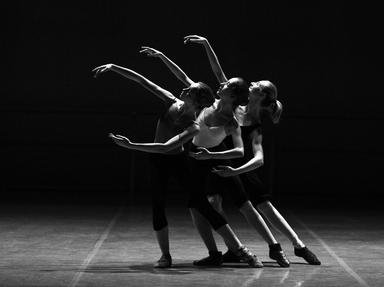Quiz Answer Key and Fun Facts
1. Jules Perrot, who was considered the greatest male dancer of the Romantic period, studied for a time under August Vestris. Vestris instructed Perrot to keep moving all the time during his dancing. What explanation did Vestris give for this instruction?
2. The first great ballet of the Romantic period was "La Sylphide". However, two different versions of this ballet were created, each with different music. In what years were these versions created?
3. The 1845 ballet "Pas De Quatre", choreographed by Perrot and produced by Benjamin Lumley, brought together four of the top ballerinas of the time. Much fuss was made (by the ballerinas themselves) over the order in which they would dance. How was this matter resolved?
4. Following the success of the "Pas de Quatre" Lumley and Perrot collaborated on two additional ballets in a similiar format. What were they called?
5. During the 1840's the repertoire of the Paris Opera Ballet included "La Peri", famous for the leap in which Carlotta Grisi leaped from a high platform into the arms of her partner Lucien Petipa. One Parisian gentleman never missed a performance of the ballet. Why was this?
6. When "Giselle" originally premiered, Jules Perrot did not receive credit for his share of the choreography. True or false?
7. The political revolutions of 1848 caused a decline in the stature of ballet in Western Europe. Which East European city became the new "center" of the ballet world?
8. The Vienna Congress had many nicknames, and one of them was given to it because of a new style of dance that was becoming popular at the time, and which was very popular at the Congress. What was this nickname?
9. From 1851 until 1858 Jules Perrot was the "Maitre De Ballet" for the Marynski theatre in St. Petersburg. What event prompted his decision to return to France?
10. After Perrot left St. Petersburg, Marius Petipa became "Maitre De Ballet". Which of the following ballets did he not choreograph?
11. Due to an illness, Petipa was not able to choreograph all four acts of "Swan Lake", and Lev Ivanov was given two acts to choreograph. Which two acts were choreographed by Ivanov?
12. Which French literary figure was also a renowned ballet critic?
13. Carlo Blasis was a famous dancer, choreographer and teacher who trained many of the top Italian dancers. Which of the following books on ballet did he write?
14. What is meant by "the girls by the fountain"?
15. How many new ballets did Marius Petipa produce between 1862 and his death in 1910?
Source: Author
snm
This quiz was reviewed by FunTrivia editor
rj211 before going online.
Any errors found in FunTrivia content are routinely corrected through our feedback system.
